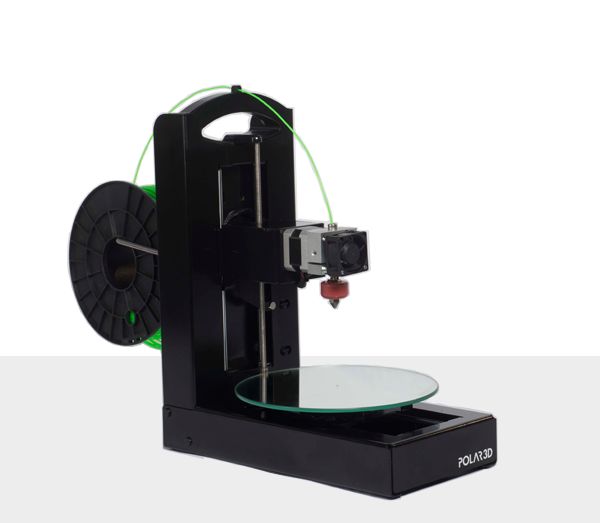Results 1 to 10 of 10
-
01-07-2015, 10:24 AM #1
Polar 3D's Polar Coordinate Based 3D Printer
One of the best aspects of CES is running across new companies and new items. One company 3DPrint took notice of this week at CES was Polar 3D, which is unveiling their new polar coordinate, FFF-based 3D printer. The printer caught Eddie's attention due to its slim, sleek appearance, small footprint, and round mirror for a build platform. The 3D printer is, says Polar 3D, the first personal 3D printer based on polar coordinates, and can build impressively large objects considering its small footprint. Polar 3D measures in at just 8" x 12.5" x 14", but it is capable of printing objects with a diameter of 8" and a height of 6". Check out more details and specs on their 3D printer in the full article: http://3dprint.com/35656/polar-3d-printer-ces-2015/
Below is a photo of Polar 3D's printer:

-
01-07-2015, 10:55 AM #2Staff Engineer

- Join Date
- Dec 2013
- Location
- Georgia
- Posts
- 934
I for one really like polar-style printers, it took me a minute though to figure out how this one handles the y-axis, by moving the spinning plate back and forth. It seems a little counterintuitive, but for the small size of the printer, it seems to work quite smoothly. I kind of wonder if the y-axis moves the motor and turntable both or if the turntable is turned by a belt or some other novel approach.
I'd consider it if the price is right.
EDIT: Apparently I missed the last paragraph... $799 is not terrible, but not right for me.Last edited by Feign; 01-07-2015 at 11:01 AM.
-
01-07-2015, 11:10 AM #3Senior Engineer

- Join Date
- Jun 2014
- Location
- Burnley, UK
- Posts
- 1,662
I don't think the table moves anywhere other than round in a circle, it has no need to. Everywhere within the build area is able to be reached with just the one radial axis.
This impresses me and makes for a very simple printer. Marlin could take a bit of effort to make it work.
-
01-07-2015, 12:10 PM #4Engineer-in-Training

- Join Date
- Oct 2014
- Posts
- 314
You still have to have three degrees of freedom to print with a polar machine. The rotation counts as one, Z axis is two, and either x OR y movement makes three. Based on the picture above it appears that this machine moves the build plate towards or away from the filament spool while rotating to achieve 3 dimensions. The benefit of polar printing is that the 2nd planar degree of freedom (the one not handled by the rotation) only has to extend to the middle of the build platform which mean the carriage, rods, etc. for that axis can be relatively small for a given print volume. The downside is that accuracy suffers the further you get from the center of the build platform because each step of rotation results in more linear movement the farther out you go. I've read that delta's are exactly the opposite, closer to center results in less accuracy because each vertical movement results in more horizontal movement. Makes me wonder if there isn't some clever way of combining delta and polar style machines to improve overall accuracy at all positions on the platform.
-
01-07-2015, 02:12 PM #5Staff Engineer

- Join Date
- Dec 2013
- Location
- Georgia
- Posts
- 934
Unless you're making the turntable completely redundant, the axial accuracy is always going to be lower the farther you get from the center (though the maximum print speed increases proportionally). Using a "Delta-style" y and z axis could be used to give you higher radial resolution at the edge, but it doesn't change the axial resolution at all, (likewise, the worse radial accuracy in the center doesn't do anything to change the better axial resolution of the bed).
Basically, though the minimum level of accuracy for either system is close enough to the average accuracy that the difference isn't particularly noticeable.
The big challenge to polar coordinate printers becoming mainstream is that lines passing through the center point of the printer have to either dwell in place there for a significant amount of time or move the plate very fast. A dedicated polar-coordinate slicer can handle this problem easily, and that looks like the direction that Polar 3D took in this case. Open source projects like the R360 reprap and other polar-style RepRaps tried too hard to be compatible with Cartesian-based slicers, doing the conversion math in the firmware and running into major problems when the math comes up with an unreasonable figure, as is the case with lines passing through the center.
-
01-07-2015, 05:09 PM #6Technician

- Join Date
- Oct 2014
- Posts
- 94
That's what I was about to ask, how do they translate the G-code into polar coordinates/moves. If it were done in firmware/hardware I'd say neato, but requiring the slicing software to deal with this would be an issue. In a school setting, sure no big deal to be stuck with their software, but in a prosumer or professional setting you probably wouldn't want to be hamstrung by one platform.
-
01-07-2015, 09:48 PM #7
Intuitively, there's something correct about a polar coordinate system. When i read Feign's comment about passing through center, i immediately thought of having a second rotating platter on top of the first to offset center. Not being well versed on the topic i thought i'd better do a little research before commenting and, wouldn't you know it, somebody's already doing it.
Polar Automation has a nifty prototype up and running, which appears to solve the "pass through center" dilemma, as well as the issue of increasing error toward the edges. Furthermore, it's a multi-tool platform, has high resolution, and is very smooth. The only issue they had was the requirement to write their own motor control algorithm.
I haven't been this keen on a new motion study since seeing Bob Potts' kinetic sculpture "Avian Pursuit".
Last edited by truly_bent; 01-07-2015 at 10:01 PM.
-
01-08-2015, 07:40 AM #8Engineer-in-Training

- Join Date
- Oct 2014
- Posts
- 314
While certainly a very clever solution to the problem, it seems that they have taken a big step backwards as far as the main benefit to a polar machine which would be machine footprint compared to print size. Comparing the size of the box to the size of the print surface I'd be surprised if that ratio is even marginally better than a cartesian machine. Now granted it's an alpha prototype and as such probably has a lot of room for improvement. At the very least it seems the lower platter doesn't actually revolve completely during a print which means it could either be made with a much smaller diameter and/or have a significant section cut out of the non-printable area of it so the machine could be made smaller.
-
01-08-2015, 11:52 AM #9
Quite right. Their design obviously wasn't to minimize the machine's footprint - the frame being quite large for the print area. They seem to be stressing the idea of a multi-tool platform, instead of just the 3D printing capabilities.
I agree. As a starting point toward a smaller footprint i expect 180 degrees could be cut from the bottom platter and still allow the top platter full coverage. Maybe more. I have a yen to put out Solidworks and start designing something similar. By far, the bigger problem would be the translating of G-code into dual rotary axis motion. I'm a programmer from way back though, and that too beckons my attention. It's just a question of commitment.At the very least it seems the lower platter doesn't actually revolve completely during a print which means it could either be made with a much smaller diameter and/or have a significant section cut out of the non-printable area of it so the machine could be made smaller.
Can't say as i've run across anything as interesting as this since... ummm, day before yesterday
-
01-08-2015, 12:58 PM #10Staff Engineer

- Join Date
- Dec 2013
- Location
- Georgia
- Posts
- 934
The Polar Automation machine is definitely an interesting machine, and they seemed to at least partially solve the center axis problem (by having the top platter capable of very fast movement.). As for the machine's size, it definitely wasn't their intent to make a compact machine here, and if necessary, they could have made the top plate about 50% larger and the tools would still have had full access to it for build volume. They were more interested in having a wide radius for the tool mounting positions though, and at one point they had simultaneous access to printing, milling, drilling turning and scanning.
But got very quiet about the project about a year ago, possibly even quitting the project altogether.






 Reply With Quote
Reply With Quote




Print not sticking to base plate?
Yesterday, 01:26 PM in General 3D Printing Discussion